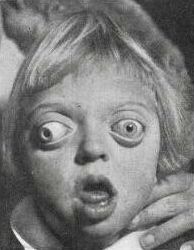
Leprosy, also known as Hansen's disease (HD), is a long-term infection by the bacteria Mycobacterium leprae or Mycobacterium lepromatosis. Infection can lead to damage of the nerves, respiratory tract, skin, and eyes. This nerve damage may result in a lack of ability to feel pain, which can lead to the loss of parts of a person's extremities from repeated injuries or infection due to unnoticed wounds. An infected person may also experience muscle weakness and poor eyesight. Leprosy symptoms may begin within one year, but, for some people, symptoms may take 20 years or more to occur.

Osteosclerosis is a disorder that is characterized by abnormal hardening of bone and an elevation in bone density. It may predominantly affect the medullary portion and/or cortex of bone. Plain radiographs are a valuable tool for detecting and classifying osteosclerotic disorders. It can manifest in localized or generalized osteosclerosis. Localized osteosclerosis can be caused by Legg–Calvé–Perthes disease, sickle-cell disease and osteoarthritis among others. Osteosclerosis can be classified in accordance with the causative factor into acquired and hereditary.

Signs and symptoms are the observed or detectable signs, and experienced symptoms of an illness, injury, or condition. A sign for example may be a higher or lower temperature than normal, raised or lowered blood pressure or an abnormality showing on a medical scan. A symptom is something out of the ordinary that is experienced by an individual such as feeling feverish, a headache or other pain or pains in the body.

Paget's disease of bone is a condition involving cellular remodeling and deformity of one or more bones. The affected bones show signs of dysregulated bone remodeling at the microscopic level, specifically excessive bone breakdown and subsequent disorganized new bone formation. These structural changes cause the bone to weaken, which may result in deformity, pain, fracture or arthritis of associated joints.

Sir Jonathan Hutchinson, was an English surgeon, ophthalmologist, dermatologist, venereologist, and pathologist.
The lepromin skin test is used to determine what type of leprosy a person has. It involves the injection of a standardized extract of the inactivated "leprosy bacillus" under the skin. It is not recommended as a primary mode of diagnosis.

Klippel–Feil syndrome (KFS), also known as cervical vertebral fusion syndrome, is a rare congenital condition characterized by the abnormal fusion of any two of the seven bones in the neck. It results in a limited ability to move the neck and shortness of the neck, resulting in the appearance of a low hairline.

Leontiasis ossea, also known as leontiasis, lion face or lion face syndrome, is a rare medical condition, characterized by an overgrowth of the facial and cranial bones. It is not a disease in itself, but a symptom of other diseases, including Paget's disease, fibrous dysplasia, hyperparathyroidism and renal osteodystrophy.

Wormian bones, also known as intrasutural bones or sutural bones, are extra bone pieces that can occur within a suture (joint) in the skull. These are irregular isolated bones that can appear in addition to the usual centres of ossification of the skull and, although unusual, are not rare. They occur most frequently in the course of the lambdoid suture, which is more tortuous than other sutures. They are also occasionally seen within the sagittal and coronal sutures. A large wormian bone at lambda is often called an Inca bone, due to the relatively high frequency of occurrence in Peruvian mummies. Another specific Wormian bone, the pterion ossicle, sometimes exists between the sphenoidal angle of the parietal bone and the great wing of the sphenoid bone. They tend to vary in size and can be found on either side of the skull. Usually, not more than several are found in a single individual, but more than one hundred have been once found in the skull of a hydrocephalic adult.

A Moon face is a medical sign in which the face develops a rounded appearance due to fat deposits on the sides of the face.

The Ugly Duchess is a satirical portrait painted by the Flemish artist Quentin Matsys around 1513.

In medical contexts, a facies is a distinctive facial expression or appearance associated with a specific medical condition. The term comes from the Latin for "face". As a fifth declension noun, facies can be both singular and plural.
A leprostatic agent is a drug that interferes with proliferation of the bacterium that causes leprosy.

The Sign of Hertoghe or Queen Anne's sign is a thinning or loss of the outer third of the eyebrows, and is a classical sign of hypothyroidism or dermatitis atopica, but it can also be detected in lepromatous leprosy. The sign is named after the Belgian Internist Eugene Ludovic Christian Hertoghe, who was a native of Antwerp, and was the first pioneer in thyroid function research.

Acroosteolysis is resorption of the distal bony phalanges. Acroosteolysis has two patterns of resorption in adults: diffuse and bandlike.

Lepromatous leprosy is a form of leprosy characterized by pale macules in the skin.
Mycobacterium lepromatosis is a bacterium that, along with Mycobacterium leprae, causes leprosy. It was only recently discovered, in 2008. Analysis of its 16S rRNA gene confirms that the species is distinct from Mycobacterium leprae.
The diffuse leprosy of Lucio and Latapí, also known as diffuse lepromatous leprosy or "pretty leprosy" is a clinical variety of lepromatous leprosy. It was first described by Lucio and Alvarado in 1852 and re-identified by Latapí in 1936. It is common in Mexico and in Costa Rica and very rare in other countries.

Rajesh Vasantlal Thakker is May Professor of Medicine in the Nuffield Department of Clinical Medicine at the University of Oxford and a Fellow of Somerville College, Oxford. Thakker is also a Consultant physician at the Churchill Hospital and the John Radcliffe Hospital, Principal investigator (PI) at the Oxford Centre for Diabetes, Endocrinology and Metabolism (OCDEM) and was Chairman of the Efficacy and Mechanism Evaluation (EME) Board until Spring 2016.

Multicentric carpotarsal osteolysis syndrome (MCTO) is a rare autosomal dominant condition. This condition is also known as idiopathic multicentric osteolysis with nephropathy. It is characterised by carpal-tarsal destruction and kidney failure.
















